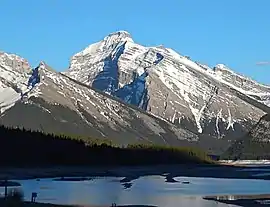Mount Sparrowhawk
Mount Sparrowhawk is a 3,121-metre (10,240 ft) mountain summit located in Kananaskis Country in the Canadian Rockies of Alberta, Canada. Mount Sparrowhawk's nearest higher peak is Mount Bogart, 3.6 km (2.2 mi) to the southeast.[1] Sparrowhawk's south slope was a candidate to be used as a ski hill for the alpine events at the 1988 Winter Olympics, but nearby Mount Allan's Nakiska was selected instead.[1]
| Mount Sparrowhawk | |
|---|---|
 Mount Sparrowhawk seen from Spray Lakes | |
| Highest point | |
| Elevation | 3,121 m (10,240 ft) [1] |
| Prominence | 256 m (840 ft) [1] |
| Parent peak | Mount Bogart (3144 m)[1] |
| Listing | Mountains of Alberta |
| Coordinates | 50°56′26″N 115°15′57″W [2] |
| Geography | |
 Mount Sparrowhawk Location of Mount Sparrowhawk in Alberta  Mount Sparrowhawk Mount Sparrowhawk (Canada) | |
| Location | Alberta, Canada |
| Parent range | Kananaskis Range Canadian Rockies |
| Topo map | NTS 82J/14[2] |
| Geology | |
| Age of rock | Cambrian |
| Type of rock | Limestone |
| Climbing | |
| First ascent | 1947 by R.C. Hind, L. Parker, Mr. and Mrs. H.H. Rans[3][4] |
| Easiest route | Scrambling[1] South slope, Easy Scramble west slope[5] |
History
Mount Sparrowhawk was named in 1917 for HMS Sparrowhawk, a British destroyer that sank during the Battle of Jutland in World War I.[4][6] This mountain's name was officially adopted in 1922 by the Geographical Names Board of Canada.[2]
The first ascent of the peak was made in 1947 by R.C. Hind, L. Parker, Mr. and Mrs. H.H. Rans.[3][4]
Geology
Mount Sparrowhawk is composed of sedimentary rock laid down during the Precambrian to Jurassic periods. Formed in shallow seas, this sedimentary rock was pushed east and over the top of younger rock during the Laramide orogeny.[7]
Climate
Based on the Köppen climate classification, Mount Sparrowhawk is located in a subarctic climate zone with cold, snowy winters, and mild summers.[8] Temperatures can drop below −20 °C (−4 °F) with wind chill factors below −30 °C (−22 °F). Precipitation runoff from the mountain drains east into the Kananaskis River and west into Spray Lakes Reservoir, both of which empty to the Bow River.
References
- "Mount Sparrowhawk". Bivouac.com. Retrieved 2018-11-27.
- "Mount Sparrowhawk". Geographical Names Data Base. Natural Resources Canada. Retrieved 2018-11-28.
- Thorington, J. Monroe (1966) [1921]. "Spray River : East". A Climber's Guide to the Rocky Mountains of Canada. With the collaboration of Putnam, William Lowell (6th ed.). American Alpine Club. p. 57. ISBN 978-1376169003.
- "Mount Sparrowhawk". PeakFinder.com. Retrieved 2019-08-25.
- Kane, Alan (1999). "Mount Sparrowhawk". Scrambles in the Canadian Rockies. Calgary: Rocky Mountain Books. p. 93. ISBN 0-921102-67-4.
- Place-names of Alberta. Ottawa: Geographic Board of Canada. 1928. p. 118.
- Gadd, Ben (2008). Geology of the Rocky Mountains and Columbias.
- Peel, M. C.; Finlayson, B. L.; McMahon, T. A. (2007). "Updated world map of the Köppen−Geiger climate classification". Hydrol. Earth Syst. Sci. 11: 1633–1644. ISSN 1027-5606.
External links
- Mount Sparrowhawk weather: Mountain Forecast